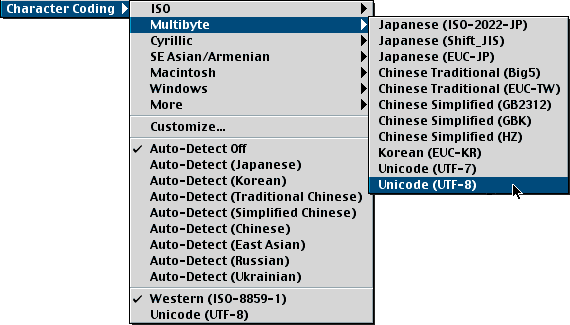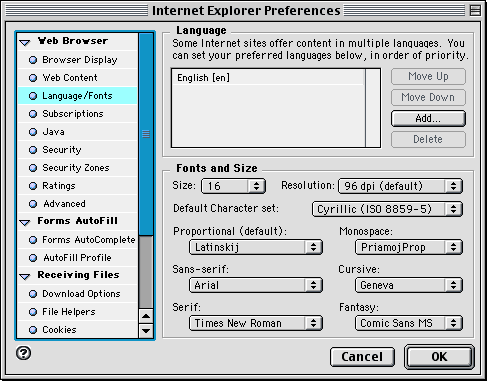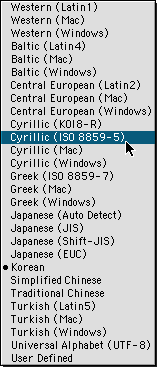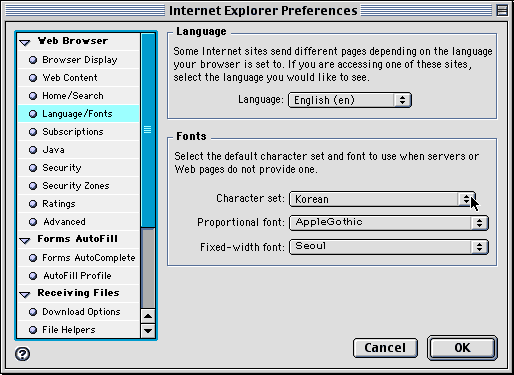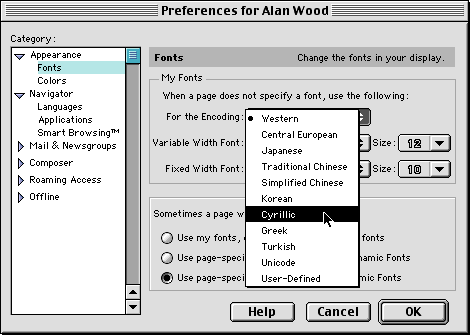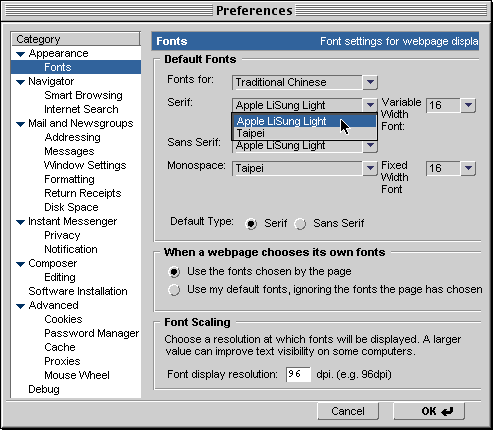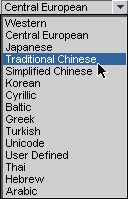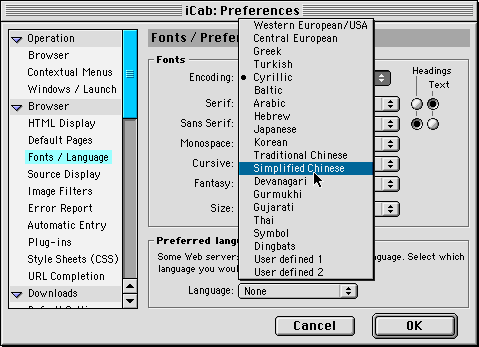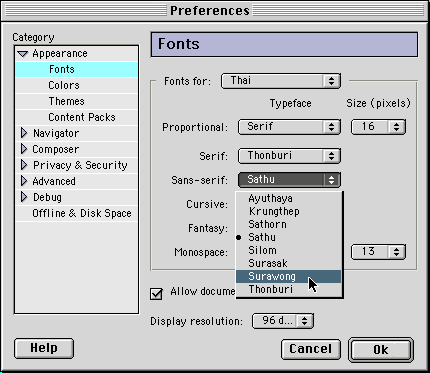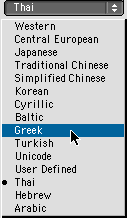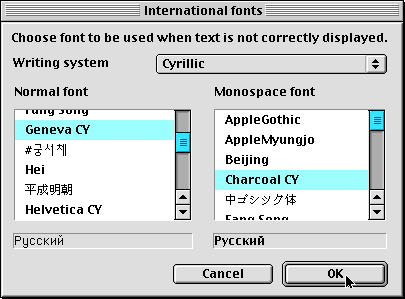Alan Wood’s Unicode ResourcesSetting up Macintosh OS 9 Web Browsers for Multilingual and Unicode SupportDisplaying Unicode characters with Mac OS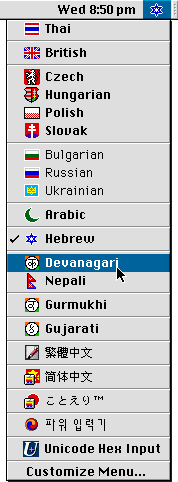
Unicode support was introduced to the Macintosh with Mac OS 8.5, including the ability to utilise not only Macintosh Unicode fonts, but also data-fork Windows Unicode fonts such as Arial Unicode MS. However, very few applications can make use of Unicode fonts: the Web browser Opera 6 can use Unicode resource-fork fonts, the editors WorldText (supplied with Mac OS 9.1), MLTE Demo and SUE can use Windows Unicode fonts, and the desk-top publisher Adobe InDesign can utilise Macintosh Unicode fonts. Apple supplies some Macintosh Unicode fonts with Mac OS 9. Microsoft supplies a Macintosh Unicode version of the Tahoma font (containing around 1000 characters) with Word 98, but the only characters that Word 98 can display using Tahoma are those in the MacRoman character set. Adobe supplies a Unicode OpenType version of TektonPro with InDesign 1.5, but it does not support the keyboard drivers in the Language Kits, and so the characters not in MacRoman can only be entered from the Insert Character ... dialog box on the Type menu. Rather than using Unicode fonts, all OS 9 Web browsers (except Opera) utilise Apple’s WorldScript technology and the fonts designed for Apple’s proprietary encodings, and attempt to map characters from these to the appropriate Unicode characters using the Text Encoding Conversion Manager. Mapping can be carried out from several of the Mac encodings within a single HTML document. To enable the display of as many Unicode characters as possible, you need to install the Language Kits that are included on the Mac OS 9 Software Install CD-ROM. A Language Kit for Unicode is installed automatically with Mac OS 9.0.4 and earlier when any of the other Kits are installed; Unicode support needs to be installed separately with Mac OS 9.1 and later. You may not want any of the CJK characters, but installing these large fonts makes available some relatively obscure characters, such as Eth (Ð), Thorn (Þ) and triple prime (‴). The Language Kits supplied with Mac OS 9 are:
The available fonts after installing the Language Kits and the Language Kits CD Extras include:
Greek seems to be handled by mapping from the Symbol font – Greek characters (without diacritics) and various mathematical symbols can be displayed without installing any Language Kits. An Icelandic Language Kit is available for Mac OS 9. A Thai Language Toolkit is available for Mac OS 9; it costs 500 Baht and is available from Apple dealers in Thailand, including some in Panthip Plaza on Petchaburi Road in Bangkok, or by mail order from Thai Toolkit software for Apple Macintosh. Apple warns against installing Language Kits on Mac OS 9 that were intended for earlier versions of the operating system. You may like to compare your browser’s ability to display the Samples of Unicode character ranges before and after installing the Language Kits, and to try the effect of changing the encoding from the View menu, using the option called either Character Coding, Character Set or Text Encoding.
Internet Explorer 5.0 and 5.1To set fonts for the various languages and character sets that are supported in Microsoft’s Internet Explorer 5:
It supports Latin, Chinese (simplified and traditional), Cyrillic, Greek, Japanese and Korean scripts. It does not support Arabic or Hebrew. Free download from: Internet Explorer 5 for Mac. Available in English, French, German, Italian, Japanese, Spanish and Swedish. A number of versions can also be downloaded from evolt.org - Browser Archive. Internet Explorer 4.01 and 4.51To set fonts for the various languages and character sets that are supported in Microsoft's Internet Explorer 4.01 and 4.51:
It supports Latin, Chinese (simplified and traditional), Cyrillic, Greek, Japanese and Korean scripts. Version 4.01 can be downloaded from http://www.microsoft.com/msdownload/iebuild/ie401_mac/en/ie401_mac.htm. It is available in English and Japanese. Version 4.51 can be downloaded from http://www.microsoft.com/msdownload/iebuild/ie45_mac/en/ie45_mac.htm. It is available in Danish, Dutch, English, French, German, Italian, Japanese, Spanish and Swedish, for Power PC only. A number of versions can also be downloaded from evolt.org - Browser Archive. Netscape Navigator 4.08 and 4.8To set fonts for the various encodings that are supported in the Navigator component of Netscape Communicator 4.0–4.08 and 4.5–4.8:
It supports Latin, Chinese (simplified and traditional), Cyrillic, Greek, Japanese and Korean scripts. Version 4.8 for Power PC (with Mac OS 7.6.1 or later) is available in English for free download from Download Netscape 4.7x & 4.8. Older versions in several other languages are available from the same location. Netscape Navigator 7The Navigator component of Netscape 7 (which has replaced Netscape 6) interacts closely with the Mac operating system, and displays only those fonts that are applicable to a particular encoding. It is based on version 1.0.1 of Mozilla To set fonts for the various encodings that are supported in Netscape 7:
It supports Latin, Chinese (simplified and traditional), Cyrillic, Greek, Hebrew, Japanese, Korean and Thai scripts. Netscape 7 for Power PC (with Mac OS 8.5 or later) is available for free download from Download Netscape 7.0x. It is available in English, French, German, Spanish, Chinese and Japanese. Older versions in several other languages are available from the same location. iCab Preview 2.9To set fonts for the various encodings that are supported in iCab:
It supports Latin, Arabic, Chinese (simplified and traditional), Cyrillic, Devanagari, Greek, Gujarati, Gurmukhi, Hebrew, Japanese, Korean and Thai scripts. Download from iCab - Download. The preview version is free, and is available in English, Danish, German, Japanese and Spanish. A version for Mac OS X 10 is available. Mozilla 1.2.1The Web browser component of Mozilla interacts closely with the Mac operating system, and in the Preferences dialog box it lists only those fonts that are applicable to a particular encoding. Development for Mac OS 9 and earlier has ceased – version 1.2.1 is the last release. Navigator 7 is based on version 1.0.1 of Mozilla. To set fonts for the various encodings that are supported in Mozilla 1.2.1:
It supports Latin, Chinese (simplified and traditional), Cyrillic, Greek, Arabic, Hebrew, Japanese, Korean and Thai scripts. Mozilla 1.2.1 for Power PC (with Mac OS 8.5 or 9.x) is available in English for free download from Old Releases (1.1a ~ 1.4 RC3). An unofficial version of Mozilla 1.3.1 for Mac OS 8.6 and 9.x is available in English for free download from WaMCom - Web and Mail Communicator. Opera 6Opera 6 is the first version of Opera to include Unicode support. Development for Mac OS 9 and earlier has ceased – version 6.0.3 is the last release. It is not restricted to characters supported by Apple’s Language Kits, and it can display any Unicode character from a resource-fork font such as BJ Cree Uni, Everson Mono Unicode, Gentium and Ragnarok Ogham. Opera 6 automatically assigns fonts for most Unicode ranges and writing systems, but you can also specify fonts for each encoding that you want to be able to display. The lists of fonts are restricted to those that support the chosen encoding. To set fonts for the various encodings that are supported in Opera 6:
To set the default encoding, which will be used to display Web pages that do not specify an encoding:
Opera 6 appears to support all of the Unicode ranges in the basic multilingual plane. More information and a free download are available from the Opera Software Web site. The free version includes advertisements at the top of the window; these can be removed by buying a licence. Copyright © 2000–2005 Alan Wood |
